Watchet's Historic Buildings QR Trail
Watchet has a fascinating history going back a very long time, most celebrated by a Viking
Invasion in 988.
Watchet has provided a QR trail on many of the important buildings and locations within the town. The QR codes are displayed on relevant buildings or locations
and will open a web page, often with "old and new" photographs, detailing what is known of that location.
Below is a list of the locations for you to find on your visit. Enjoy looking for them all!
Alberts Ardware
Anchor Inn (Latterly Watchet Radio Musueum)
Old Custom's House (Latterly known as Lloyds Bank - now private)
The Bell Inn
Old Train Goods Shed (Latterly the Boat Museum & Visitor Centre)
Central Hotel (Latterly Marie's Place & The Treasury)
Chemist Shop
Clara Mann, Coram & Little Butchers
The Esplanade Club
Corner Cafe (Latterly known as Serendipity Cafe)
Lynda Cotton Gallery
Council Chamber (Latterly Watchet Angling Supplies)
Explanade lane Hairdressers
Fire Station (Latterly Harbour Community Book Shop)
The Fitzroy Barometer
The Foundry
Georgian House
Esplanade Lane Hairdressers
Lifeboat Station (Latterly Watchet Library)
The London Inn
St. Margaret's Hospice
Old Market Square (Latterly nown as "Mrs Hibberts" and Chives Cafe)
The Milk Bar
Mineral Yard Terminus (Latterly the Spice Merchant and Garage)
Market House Musuem
Methodist Church
The Ritz Cinema (Latterly Amusement Arcade then Marina Shop)
The Sanctuary
Swain House
The Star Inn
Van Heusen Shirt Factory (Latterly Opticians and Doctors' Surgery)
St. Decuman's Church
St. Decuman's Well
The West Somerset Hotel
Below is a comprehensive history of our town. You can jump straight to:-
History of Swain Street
Watchet Esplanade
St. Decuman's Church
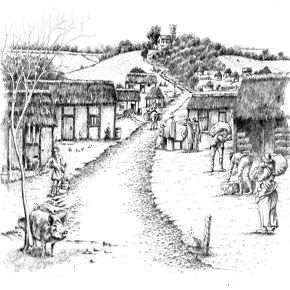
from 14th Century
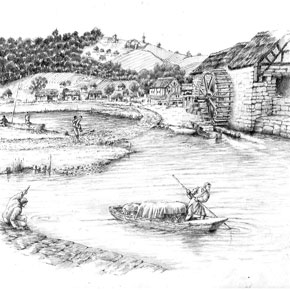
from 14th Century
Origins of Watchet
These are an artist's impression of how Medieval Watchet may have looked a little before St Decuman's Church was built. It seems likely that the location of the rich fertile valley that carries the Washford river to the sea may well have seen a great deal of pre-historic activity although what is now for most of the year a gently meandering stream was at one time much more impressive in size.
There is scant evidence of Stone Age man here, although a number of minor discoveries have been made - a few relics of mammoths perhaps and linking it with the harbour improvements of 1860 and 1861 when a couple of mammoth tusks were said to have been unveiled. This later led to further discoveries, notably by Leslie Wedlake, the co-founder of the Market House Museum, in the summer of 1949 at Doniford. Wedlake explains that the tusks probably arrived in the floodwaters of one of the glacial periods.
We are imagining a period before the construction of the outer harbour proper, and a little while before the erection of our oldest building, St Decuman's Church. There are several important aspects to consider in this illustration which, shall we say, is imagined as just before the Norman Conquest. A certain amount of trade is being carried out based around a small settlement at the mouth of the Washford River at this date. We know that the river was wider than the one we are familiar with today and that it had a small island in the middle, which was accessed via a ford. There would have been some small amount of sea trading at this date and, as anyone who has looked over the bridge near the Star Inn on a high tide will realise, this tidal river would have easily reached Waterloo Cottages.
The undershot watermill is included as it is well-recorded as being the principal town mill. We can be sure that there was a mill in Watchet at this date as one is recorded in the Domesday Book - although we cannot assume it was the one located here in the basin. More significant, however, are the Saxon buildings on Cleeve Hill, seen in the distance overlooking the activity in the basin.
The problem with Saxon establishments, unfortunately, is that they favoured timber as opposed to stone with the result that identifying a settlement such as this, although not impossible to excavate, requires a very knowledgeable eye which may account for the reluctance to do so thus far.
Just about everyone local is familiar with Daws Castle on Cleeve Hill and its elevated position overlooking the cliffs on one side and the valley and town on the other. This ancient fortification was excavated by English Heritage in 1982 revealing two stages of development of the fort in the tenth century. English Heritage continues to administer this site. Daws Castle occupied an area of 5 acres and was an important and extensive fortification.
It seems likely that within or hereabouts would have been the Watchet Mint which existed for some considerable time, starting in 977 and the final coins being struck in 1158. The probable importance of this site and the surrounding fields cannot be over-emphasised and to date, although recognised as a good candidate for archaeology, no attempt has yet been made to explore the potential.
The naming of Saxon Close and Saxon Villas is an indication and no accident in referring to its ancient history for here in this lofty and often windy location were arguably the very beginnings of the town of Watchet. It must be said that at this period Watchet was at its most important and influential in the town's history. Daws Castle, in the event of a Viking raid, would have been a place of refuge and from accounts of the period was well defended. Of course it needed to be as within its boundaries was the Mint, quite possibly why it was so attractive to the raiders. There must have been a good few dwellings in close proximity to the fort and Mint and the surrounding dwellings would have been of rude appearance, meaning fairly basic. However, there is one building that would have been of considerable importance and that was the Minster.
Today, an adjacent plot has been known as Minster Field for at least 250 years and it seems more than reasonable to suppose that it was located within the boundaries of this field. It is more than likely it would have been constructed with timber and thatch and for how many years it stood here is impossible to say. The illustration shows the Fort, Mint and Minster high on the hill with a cluster of thatched dwellings close by and also a strip field system for growing crops.
Do we suppose that Watchet began as an important fortified 'town' on Cleeve Hill or do our origins begin in the river basin, or are the two inexorably mixed and should we look to an even earlier period?
Let's look at the earliest known written reference from the year 918 - Waeced which, translated, means 'under the wood.' I must say although undoubtedly much of the surrounding countryside would have been woodland, it would have been nice to have been 'under the fort'!
What this illustration principally coveys is that, potentially, Cleeve Hill holds many secrets yet to be uncovered which may be even more significant than is already obvious. With suggestions and some evidence that here was once an Iron Age fort, our town's history might be much older than we thought.
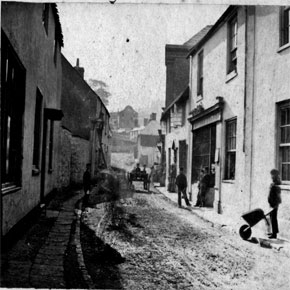
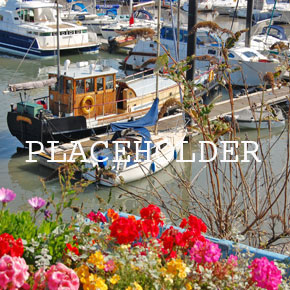
Swain Street
Swain Street is the principal street of our town but just how long this thoroughfare has existed here might be a surprise. It is quite possible that it developed at least seven or eight hundred years ago, perhaps not quite as we know it today, but certainly the foundations were laid.
These early buildings would need access to the river for obvious reasons and so pathways and perhaps little jetties were built for the loading and unloading of goods. Looking at the street today, it might be surprising to know that many of the facades conceal many seventeenth century features in their interiors. There are several 17th century fireplaces with their elm bressemers (beams supporting a fireplace), some even with tell-tale witches' marks and merchants' marks carved into the elm of which these beams are invariably made. Excavating one such example revealed a child's shoe, more interesting than the usual clay pipes! It was quite common to place things up the chimney, mostly to ward off the devil or evil spirits of course. I'm sure everyone knows that you must stuff an onion up your chimney if you are newly arrived at a house to counteract any possible unwelcome visitations.
Swine Street was the original name for this particular thoroughfare of Watchet and its derivation is still under discussion, including a possible link with the Danish prince Swayne. This interpretation would be a just around the time when St Decuman's Church was built.
There was already considerable trade being carried out here and it was probably a time when the woollen trade was set to dominate the local economy. The houses and places of business were virtually all constructed of wood combined with an early form of wattle-and-daub and thatch made from a combination of straw, bracken and heather. There would have been a number of specialist tradesmen operating in Watchet at this time, although it must be conjecture as to what they were, although a blacksmith and rope-maker might be a good bet!
Life in Swine Street in 1400 would have been a good deal more uncomfortable in those days and keeping warm and cooking were high on the list of priorities. You will notice that there are no chimneys - they didn't make an appearance in domestic dwellings for quite some time. The fire would have been a central hearth and the smoke just made its way up and through the thatch - there was one advantage in that it was effective in killing a number of unpleasant creepy crawlies.
There was also virtually no furniture or any of the other forms of interior features familiar today and cooking utensils were very basic and of course no fork - just a knife! The sanitary arrangements were virtually non-existent and the village dung heap would have been something to avoid. There is plenty of potential to explore life in 1400 but let's consider the illustration and certain aspects of it. Here, we are looking south-west along Swine Street and a meandering path taking you past the Lime Cross and on to the Church overlooking the settlement in the valley below. There were (and evidence remains) of many such crosses throughout Somerset and the South West and confirmation remains of its existence today all these centuries later.
If you find yourself sitting in the Bookstop next to the Visitor Centre, it is even possible that you might be occupying the very spot where it once stood for this area is known as the Cross and is a direct reference to this ancient part of our town's history. This is one of three crosses within the boundary of the town, remembering that at one time a further cross must have been located somewhere near the present Market House Museum. I'm pleased to say that we do still retain the third cross and it is there for everyone to see in the churchyard of St Decuman's. This ancient cross, or what remains of it, was almost certainly there at the time of the scene portrayed in this drawing.
This was an important development in our future history as the town, rather than being valued as an important and strategic defensive site, was now rapidly developing as a trading centre and port. It was the beginning of what was to become a long and fascinating maritime history that was to suffer many ups and downs over the following centuries.


St. Decuman's Church & Surroundings
St. Decuman's Church must have appeared as a spectacular building at that time. Centuries later, it remains the oldest building by far in the town. Some six hundred years later, entering the church for the first time, it is impossible not to be aware of the incredible sense of history this special building is imbued with. Much of the surrounding land, once nothing more than woodland, was being cleared for agriculture and the landscape was changing rapidly with the Agrarian Revolution just around the corner.
Why the church was located here, recorded written history doesn't tell us and so we can suppose what we might like. It was quite common for Christian churches to be built on pagan sites and of course, the much-visited Well would without doubt have been an important focal point, maybe for pagan worship before the church was built. Of course, we may decide that as this was the site of the decapitation of St Decuman and the remarkable events that followed - this would make this symbolically the obvious place to build a church. What of the Minster that occupied the area of the Saxon village that I mentioned yesterday? The fact that it was certainly of timber construction with thatched roofs would have made it vulnerable to harsh sea winds. By this date, Daws Castle had long since lost its importance as a defensive fort and, following the Norman conquest, the local population were unlikely to be plagued by the unwelcome attentions of the Viking raiders. Did it make more sense then, as the emphasis had changed, to move the Church to a position more accessible to the ever-increasing settlement situated at the mouth of the Washford river?
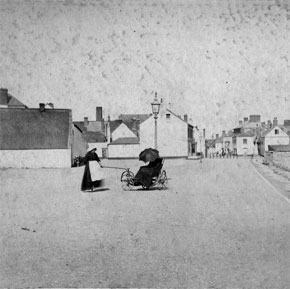
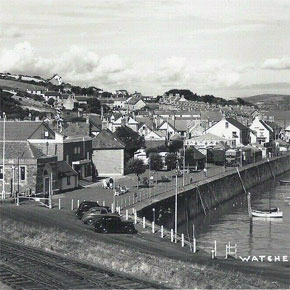
Watchet Esplanade
When the artist Turner visited Watchet in the early 1800s to record the harbour, what is now the Esplanade did not exist and was nothing more than a gentle sloping shingle beach, as portrayed in the well-known engraving of Watchet by Cooke after Turner's sketches.
At this time and for a good few years thereafter, the majority of Watchet was owned by the Wyndham family. It may well be that as the sea has a reputation for being a bit lively here and was regularly causing damage to his property, the then 4th Earl of Egremont decided on building the wide expanse of what we know as the Esplanade, which was completed in 1843.
Since that date it has been a venue for many of Watchet's events, almost too numerous to mention, that have included regattas, open air concerts and at one time, a visit from the annual funfair. Today the tradition is continued with our highly successful open-air market just yards away from the site of the original medieval market along with many community events.
The remarkable photograph (above) is taken by James Date, the most important figure in recording the history of Watchet in the nineteenth century. It is I think one of the photographer's finest images, so cleverly posed and so evocative of Mid-Victorian Watchet. Gas lighting had come to Watchet by the time Date took this photograph (which I'm going to say is around the date when it was installed in 1867). I am assuming that because Date was very quick to record any innovations as soon as they came to fruition!
It must have been a very eerie experience to make your way home from one of Watchet's various hostelries with only the light of the flickering gas lamp to guide you. A good deal of care was necessary also, as it was to be some years before the safety railings were installed. Although the makeup of the Esplanade has changed little since this photo, many of the buildings have been cosmetically improved from their original use or been adapted to suit the new changes or trends as the decades have advanced.
It would be fair to say that each building has a unique history and deserves a post of its own, so this can only be a generalisation. There are two distinctive late Georgian buildings, one of which is Grade II listed, Esplanade House which at one time served cream teas in the beautifully maintained gardens. The other property near the slipway maybe a little older but none of the original exterior features remain. It is likely that both of these were built on the sites of much earlier medieval buildings.
Until comparatively recently, Watchet had three banks and this was the home of a branch of Lloyds. The Esplanade Club, a very popular and vibrant place for locals and visitors alike, was purchased by a group of local Watchet men in the early years of the twentieth century and was for a time the BBC Club and for the benefit of those employed at the BBC transmitting station at Washford Cross, now the Home of the Tropiquaria Zoo. There are several possibilities for its use prior to this date, the shape perhaps suggesting it may have once in the very distant past have been a long house, but that is pure speculation. What seems more certain is that for a time it was a sail-making workshop. The building is still retained as a community asset under the watchful eye of the trustees.
Not surprisingly, there was a blacksmith working close to the harbour in the nineteenth and early twentieth century and known as 'Parsons Blacksmith Shop', now the site of David Milton's wonderfully evocative sculpture 'Standing Stones'. The newly refurbished much loved Community Bookshop was until recently combined with the Tourist Office and has been secured for the town and its future seems secure.
Thomas Barton Peel's Art Deco Cinema, originally the Conquest and later renamed the Ritz, retained that name when it ceased to be a cinema and became an amusement arcade and now a chandlery where you can visit the cafe, enjoy an ice cream or ascend the stairs to visit 'Rogers Furniture' which it has been suggested is the 'Lego capital of the West. Thomas Barton Peel was certainly not only a great character and an innovator, but a most imaginative entrepreneur. He was responsible for the building of the most wonderful, unique and remarkable of all Watchet buildings, Shanghai Bungalow. More of Mr Peel elsewhere.
James Date was recording much of Watchet's transformation from just a humble port on the Severn Sea to the bustling industrial hub of West Somerset through the 1860s and 70s. The most significant development regarding the Esplanade would without doubt have been the erection of the Lifeboat House in 1875 . It is now the town library, next door to the Phoenix Centre. Both the Phoenix and the Library have their own individual stories both enthralling in their own way.
In the archive, the Conservation Society have many photographs of the Esplanade and many more postcards dating from the late nineteenth century when it became almost compulsory for visitors to send a shaft of postcards to friends and relatives. Until the invention of the telephone, it was by far the best means of communication, with some certainty that postcards sent on one day would arrive on the following day!
This page is provided by Watchet Conservation Society with the help of Watchet Chamber of Trade
Text and history provided by Nick Cotton
